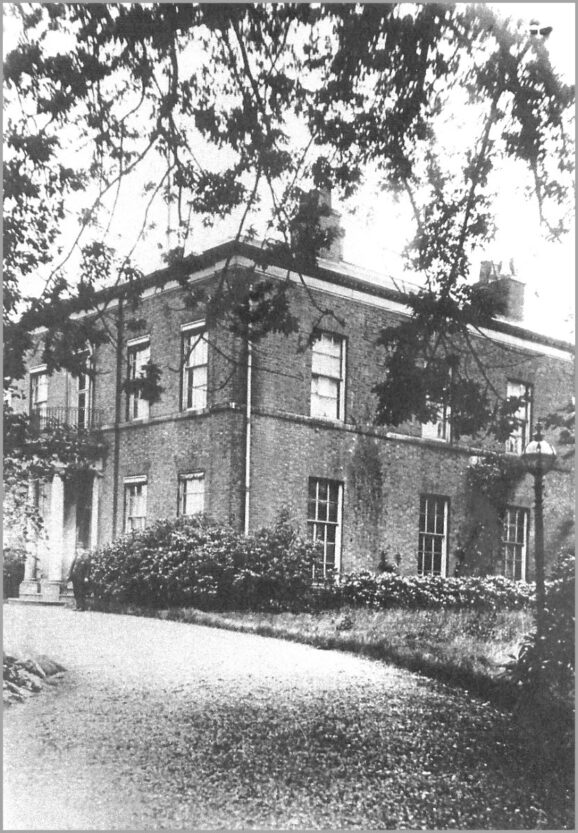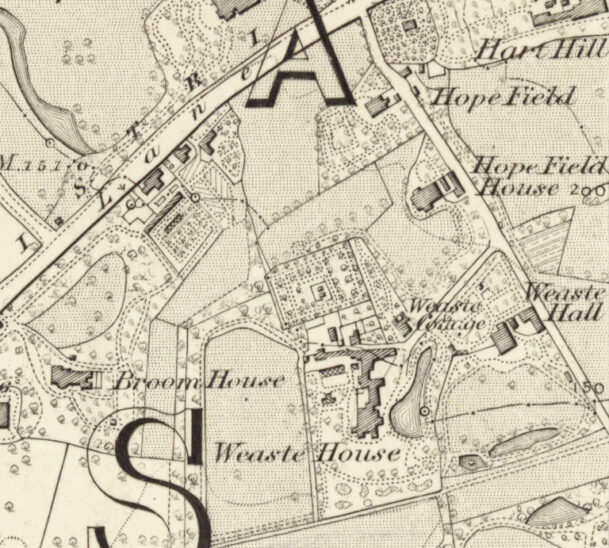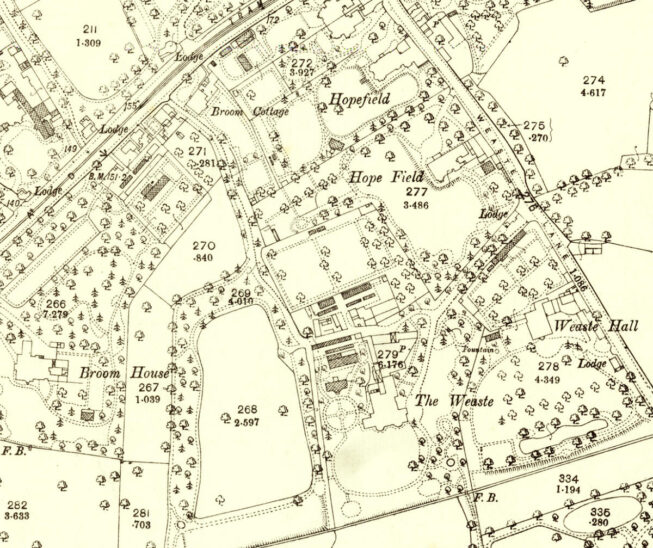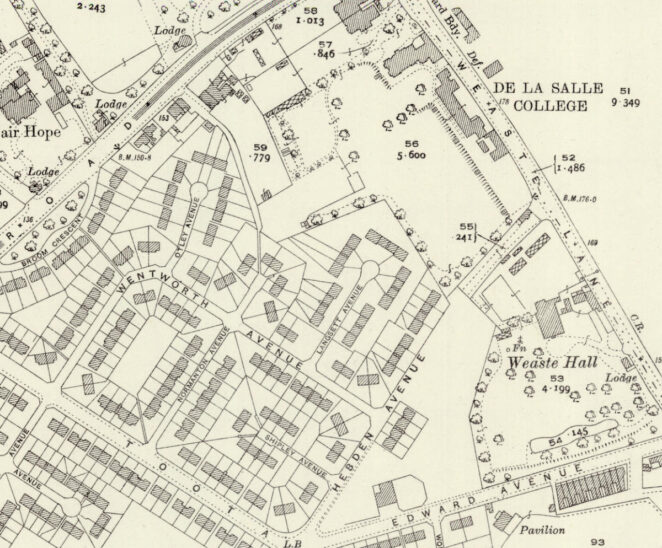Weaste Hall
Weaste Hall, built around 1831, was a large detached house on Weaste Lane in Pendleton. The house has gone but we can gather much information about it by comparing the photograph with several sale descriptions. These also give a fascinating description before industrialisation had fully impacted on this area of Pendleton. Built to appeal to the business class this late Georgian residence had the latest, up to date facilities and convenient proximity to Manchester’s commercial centre.


Capital Mansion House, Offices, Garden, and Pleasure Grounds. etc., delightfully situated, called WEASTE HALL. BY MR MORRIS, On Wednesday, the 15th June next, at Hayward’s Hotel, Bridge-street, Manchester, at five o’clock in the after noon, subject to such conditions as will be then produced: THE FEE-SIMPLE of and in all that MODERN BUILT HOUSE, called WEASTE HALL, situate in the township of Pendleton, within about 250 yards of the Liverpool Road, nearly fronting Hope Hall, and distant from the Manchester Exchange three miles; together with the OFFICES, GARDENS PLEASURE GROUNDS, being in the whole, including the site of the Buildings, EIGHT STATUTE ACRES or thereabouts. The house is lately built, and finished in the first rate manner, having a handsome portico of best Yorkshire stone, and entrance hall with elegant staircase, and back stairs for servants; and with every convenient fixture throughout-the cellars are dry and excellent. The dining room is 24 feet by 19; the drawing room 20 feet by 18; the breakfast room 18 feet 6 inches square; the nursery 20 feet by 15-all 12 feet high-the kitchen 20 feet by 18, with back kitchen, pantries, and large store room, fitted up with cupboards, and drawers, etc There are 5 large bed rooms, with dressing closet, servants room, and four good attics well lighted; water closet, and capital cisterns. The situation is one of the finest in the county, (fronting the south) commanding most beautiful and extensive prospects over a picturesque country, and, what is perhaps singular, never likely to be injured, and in the midst of a most respectable neighbourhood. The PLEASURE GROUNDS, SHRUBBERIES, and GARDEN, are laid out and planted with the greatest taste, and there is a large fish pond a little distant from the front of the house, supplied with excellent water. The OFFICES comprise gardener’s cottage, double coach house, billiard room, three stalled stable and harness room, good shippon and other stables; with hay-lofts over. The GARDEN contains about an acre of ground, completely walled round, with a peach and nectarine wall eighty yards long, fronting the south, and is well stocked with the choicest fruit trees. The Property is deservedly worth the attention of the gentleman or the capitalist, and such as seldom comes before the public being every way calculated to suit a family of the greatest respectability. For further particulars, or a view of the Estate, please to apply to Mr. CROFT, upon the premises, any day prior to the sale, before one clock. If required, one half of the purchase money may remain on security of the Estate. Manchester Times – Saturday 21 May 1831

Weaste Hall was occupied by three families during its short lifespan of 108 years.
John Walker (1792-1879) Along with his wife Hannah Birch and her sister Eliza, Walker was most probably the first occupant of Weaste Hall. John Walker was a cotton merchant and a proprietor of the Bank of Manchester. He was the son of John Walker and brother of Samuel of Prospect Hill. The Walkers were closely involved with the Manchester Natural History Society where in 1856 John Walker was elected treasurer on the death of his brother Samuel. He was also involved locally with the Weaste Lane Sunday school where he was superintendent for 11 years until 1857. The teachers and pupils presented him with a bible on the occasion of the Walkers move to Leamington Spa where Hannah died in 1860 and where John Walker saw out his years as a landed proprietor.
Arthur G Latham (1821-1881) The second owner of Weaste Hall was an East India merchant and a partner in Arbuthnot and Ewart who traded in commodities. Latham was a Director of the Royal Exchange, Manchester, a Salford JP and church warden at St Luke’s, Weaste. He married Jane Brererton in 1846. Soon after their marriage they moved to Bombay, India where several of the Latham children were born. At the time of the 1861 census the Latham family were living at Weaste Hall with several servants including a butler, housemaids and a nurse. Arthur Latham died suddenly in 1881 and was interred at St John’s, Pendlebury. Less than a year later the house was put on the market. The advert gives additional information: ‘1882 WEASTE HALL. Eccles Old-Road.- In consequence of the death of the owner, Arthur G. Latham Esq., this very attractive Residential PROPERTY is to be SOLD, by Private Contract, with early possession. It contains a good entrance-hall, four reception rooms, numerous bedrooms, good kitchens, pantries, housekeeper’s and other usual offices. The site of the hall and grounds is six statute acres, which is adorned with some fine old trees and a portion of it is available for the erection of other properties if desired. There is a convenient entrance lodge with stabling of a superior description, including accommodation for a coachman. The conservatory and vinery are of moderate dimensions. The gardens can be maintained at a light cost and there is productive kitchen garden. This eligible property is situated in one the best suburbs of Manchester whilst being very secluded and within easy distance of the city by railway or by road. For additional particulars and to order a view, apply only J. R Bridgford & SONS, 30, Cross Street’. Manchester Courier and Lancashire General Advertiser – Saturday 18 February 1882
Henry Lighbown (1819-1899) Lightbown probably bought Weaste Hall around 1884 when a sale of the house had been finalised by the Latham family. From 1884 until 1929 Weaste Hall was to be the Lightbown family home. On Lightbown’s death his widow Anne and their unmarried daughter Annie Milton Lightbown continued to live at the Hall. Anne died in 1908 and Annie Milton stayed on until her death in 1929. We can find no further evidence of residents between 1929 and 1939 and the house may have been empty until its demolition on the eve of World War II.


Demolition 1939 Three separate sales by demolition merchants took place in 1939 when the house appears to have been stripped of every conceivable item of worth including its ‘Count and Ton Slates. Heating Apparatus, Doors, Windows. Lead Light Roof and Bays, Panelling. Stone Portico, Flags, Steps, Coping, Garage and Yard Doors. Stable Fittings and Bosklns. Greenhouses. Fireplaces, Ranges, Boilers. White Sink and Washbowls, Glass Dome, Stone Staircase. Trunk Ventilators’.
St Lawrence R C secondary school. In 1946 the press reported that four new Roman Catholic Schools secondary modern schools would be built in Salford. The one at the Weaste Hall site, to be known as St Lawrence, was opened in 1960, some fourteen years after the initial announcement. St Lawrence was later renamed All Hallows Business Enterprise and Sports College. In 2014 All Hallows was demolished and a new Church of England primary school, St Luke’s, was built on the site. All Hallows was rebuilt on the historic Hope Hall estate, Eccles Old Road..






the site of Weaste Hall.